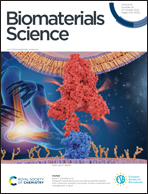Artesunate drug-loaded 2D nano-shuttle landing on RBCs infected with malaria parasites†
Abstract
Artesunic acid (AS0), a derivative of artemisinin, is recommended for the treatment of severe and complicated malaria, but its use is limited because of limitations such as a short half-life, non-specific targeting capability, low bioavailability, etc. To overcome these issues, a novel 2D inorganic delivery shuttle system for an AS0 drug to target the malarial host, red blood cells (RBCs), is explored by immobilizing AS0 into 2D metal hydroxides to form AS− (artesunate, the deprotonated form of artesunic acid) nanohybrid drugs. Haemolysis assay showed that the AS− nanohybrids not only are haemo-compatible but also target RBCs due to the electrostatic interaction and hydrogen bonding between RBCs and AS− nanohybrids. As clearly demonstrated by the subsequent parasite lactate dehydrogenase assay, the antimalarial effect of the AS− nanohybrids is determined to be 6 times more effective than that of intact AS0 against malaria. Therefore, the AS− nanohybrids with haemo-compatible 2D inorganic carriers could be the promising drug delivery systems for targeting the malarial host, RBCs.



 Please wait while we load your content...
Please wait while we load your content...